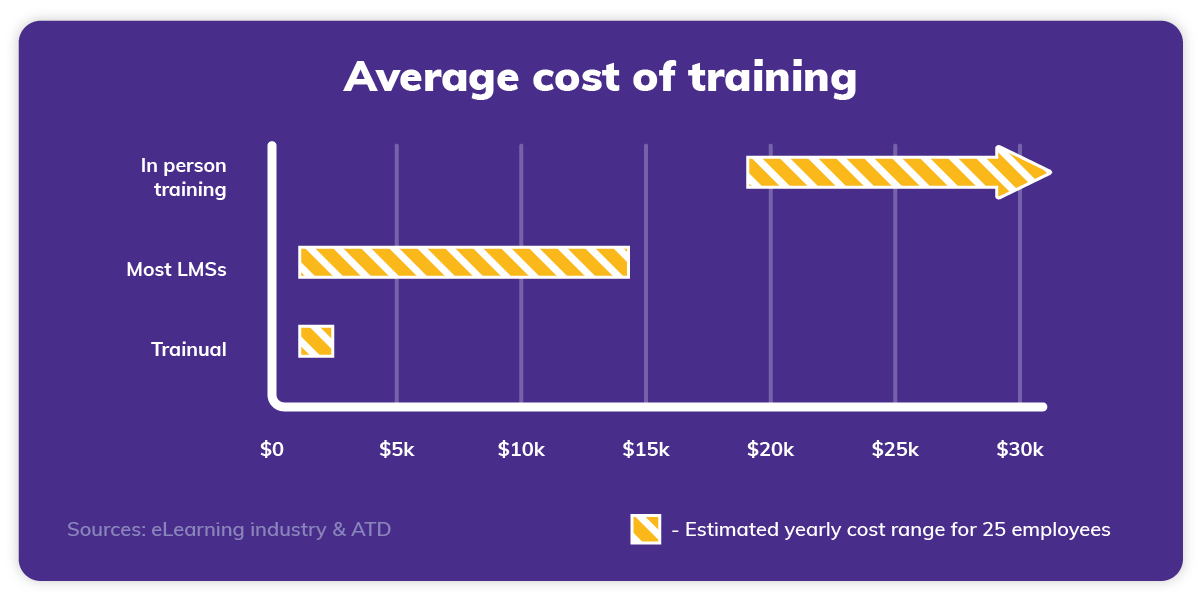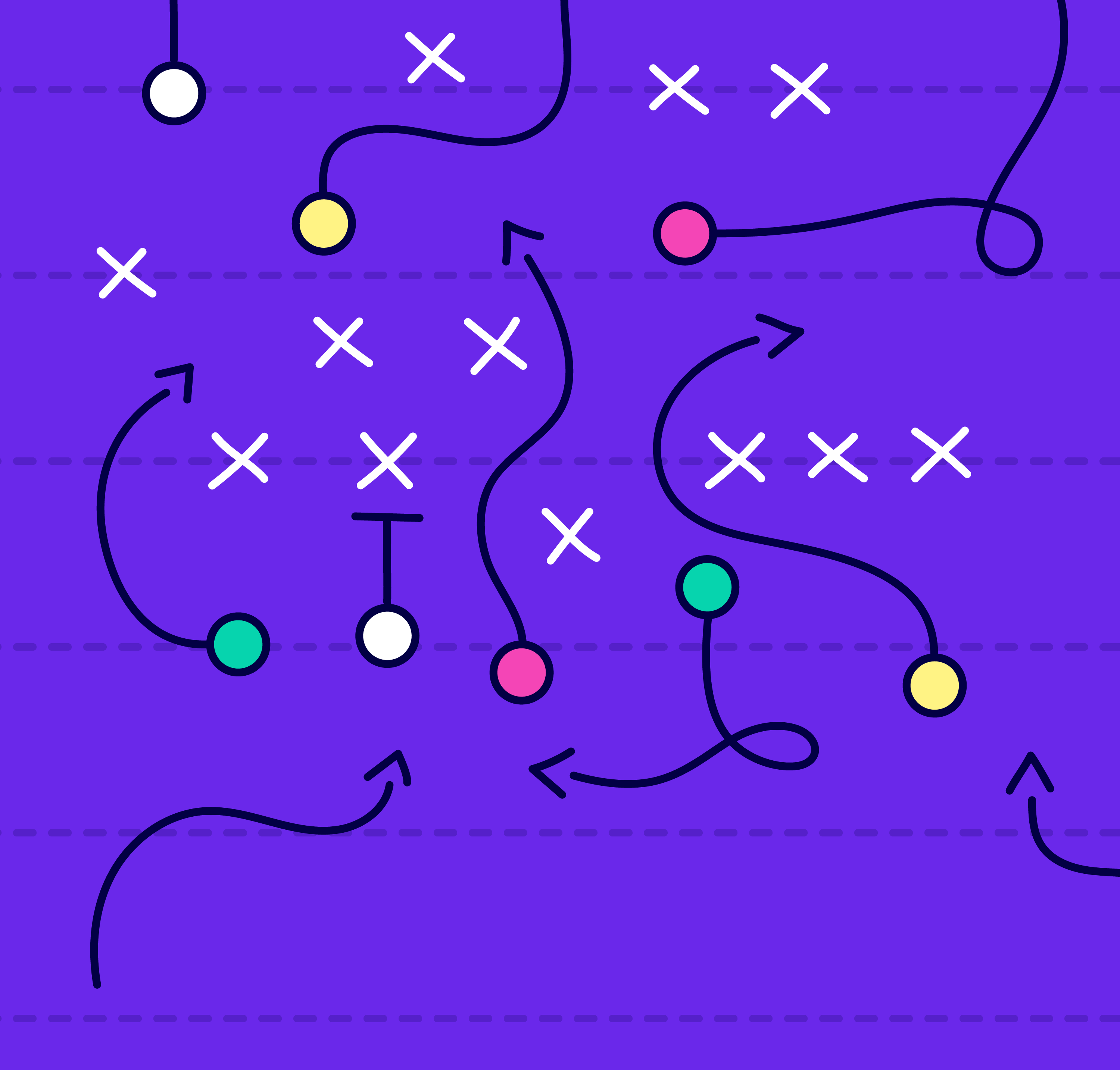
Articles
What Is A Learning Management System (LMS)?
April 5, 2021

Roughly 83% of companies have ditched getting their team up to speed with pens and paper – and taken their training online with a learning management system.
Before learning management systems were a thing, training meant sitting in a classroom as an instructor droned on and on. It was overwhelming. And honestly, most people didn't learn a ton.
But since learning management systems, companies have an online learning platform. One where they can create training content, roll out how-tos, and assess their team's knowledge. All while making their team's training much more engaging and effective.
👉 Spoiler: Now, there's an even better alternative to traditional learning management systems. One that gets your team up to speed faster, boosts employee engagement, and costs a fraction of traditional learning management systems. We call it: Trainual.
What is a learning management system?
A learning management system (or LMS, for short) is software that automates your employee training and makes it accessible from anywhere.
That's because an LMS helps you create online training content. Delivers that content to the right employees – so they can train at their own speed. And tracks your trainees' progress.
To do all this, a learning management system has 2 sides: the back end and the front end.
The back end (or admin dashboard) is where you create and manage your training materials. You can add new users, assign relevant training, and view your employees' progress – all from one place.
The front end (or user interface) is what employees see when they're added to the system. It's where they can see all their assigned content and actually go through their training. And it's accessed via a web browser or mobile app. So, employees can log into it at any time.
And the best part is it doesn't pull on your managers! Because, unlike instructor-led training, your employees go through training on their own. Everyone gets the same, consistent training. And all you need to do is hold them accountable for what they learned.
This employee training win has led the eLearning industry to explode (by a whopping 900%) since 2000. And as companies opt for remote arrangements, the industry grows even faster.
In fact, IBM reports that the time to ramp up employees in-person takes 10 times longer (at 36 days) than it did in 2014 (just 3 days). Meaning, it simply isn't cost-effective to train people in person anymore.
Instead, companies need employee training built for scale and speed – making learning management software the obvious first choice. But not necessarily the best option - and that all comes down to SCORM.
What is SCORM?
SCORM (Sharable Content Object Reference Model) is a set of technical parameters that allows you to easily move your training content from one LMS to another. Similar to how a DVD will play just as good in a SONY or LG DVD player.
So, when an LMS brags about being SCORM compliant, they're saying their software will play nice with your existing content. But only if that content meets SCORM criteria – which often requires an additional LMS authoring tool.
Luckily, there's lots of existing SCORM content available for you to use. But it's going to be high-level and industry-specific. So, your team won't learn how your business specifically does what it does. And they won't walk away knowing how you expect them to do their job.
And while you might be thinking that you'll just update the content to fit your needs, it's not that easy. SCORM technology hasn't seen any major updates since 2004 (which makes it ancient as far as technology goes). This makes the content nearly impossible to customize to your business.
So, while SCORM compliant sounds super great, it really just means a higher price tag. And all you're getting in return is hard-to-manage training content that doesn't do what you need it to. This causes big problems for the businesses trying to scale.
Who needs an LMS?
Most learning management systems target enterprise-sized companies (companies with 500+ employees). But businesses of all sizes rely on an LMS-like solution to create, distribute and manage their training content online. And the ones who benefit the most are the companies struggling to train and grow their team (AKA younger, smaller businesses).
Maybe your employee training has never been online. Maybe your team is growing quicker than you can train them. Or maybe ramping up your employees takes way too long. Regardless of the obstacle, if you plan to scale any aspect of your business, you'll probably consider adding an LMS to your tech stack at some point or another.
That's because an LMS is a centralized place for all your training content – where new and veteran employees can easily find the answers they need. So, you can hold them accountable for doing things the right way.
This way, your processes become repeatable and consistent – no matter who's doing them. And you're set up for rapid growth.
But here's the catch: traditional LMSs come with a hefty price tag. Partly because they're "SCORM compliant." And partly because enterprises (AKA their target customers) can and will afford it. So, they can charge thousands of dollars per month and don't think twice about how it affects your business.
🔥 Tip: Trainual, the #1 momentum leader in G2's LMS category, starts at just $99 per month. Meaning, it's the best - and the most cost-effective. Try for free.
Benefits of using an LMS
With a price tag that big, you need to know whether or not an LMS is worth it - before you commit. And while the benefits are great, we'll let in on a secret: there are better tools available (like Trainual) that allow you to do all this and more for a lot cheaper.

Easily update training content
When all your tribal knowledge is documented online, it's easy to update your training content the minute something changes. Whether there's a new way to bill customers or you switched to a new CRM, you can hop into the LMS and edit the content the same way you'd edit a Word document.
The best LMSs then will automatically notify anyone assigned the content, letting them know it's updated. That way, everyone learns the new and improved process as soon as it's rolled out.
With in-person training (or whatever system you're trying to make work right now), it's more difficult to manage changes. You have to find where the documentation lives, rewrite what you had, and redistribute that knowledge.
It's total chaos. Especially compared to just hitting publish on your LMS. And having the most up-to-date version available to everyone on your team.
Lower training costs
An LMS noticeably lowers your training costs long term. Because you'll no longer need to hire a trainer, allocate managers, or print out endless packets of information.
Instead, simply upload all your training content into your LMS. And your employees can go through their training online on their own. That way, your managers can get back to work and focus on the important things – like running your business!

Plus, you can see exactly where each employee is at with their training. Because the best LMSs will track their progress and test for comprehension (with tests and quizzes).
🔥 Tip: Trainual is the top-rated LMS alternative that lets you streamline your training process – at a fraction of the cost. Try for free.
Learn at their own speed
Employees train on the LMS on their own. So, they can take as long as they need to learn the content (within reason, of course).
It may not seem like a big deal, but information overload is a very real thing. The average person will forget most of what they learned in 24 hours. And employees who are rushed through training have to revisit the information again and again.
This is a common problem with in-person learning. Because trainers set the pace – and they typically go through the content as quickly as possible. So, no matter how hard they try to make it engaging, the reality is they're going to lose people along the way.
But an LMS lets people learn at their own speed. Employees can take as long as they need on each section. And they can even re-do a course if it doesn't stick.
Plus, when an employee starts to feel overwhelmed, they can take a break from the training. Or in other words, stop before they hit information overload! That way, employees actually retain what they learn and get up to speed more quickly.
Stickier training
In most cases, an LMS lets trainees choose their own adventure. Meaning, employees will learn all the same info – but the way they interact with it might differ slightly.
For example, your training might write out directions and provide a quick video explaining how to do something. And employees can pick whichever one they think will teach them best. So, the training ends up being more engaging (and equally more successful).
It turns out that adults learn a lot differently than children. Because our brains are already packed with information. Meaning, you need to teach adults differently, too.
Basically, you need to stop relying on traditional training methods drawn out and, let's face it, boring. Because with an LMS, you can break up content and make it more digestible. You can add videos for visual learners. And you can even embed fun GIFS to get a reaction every once in a while.
Because here's the reality: training doesn't have to be a snooze! It can (and should) be interesting, engaging, and even make people laugh. And it turns out that these things actually make your training better – because the information sticks the first time.
Train from anywhere
Since an LMS delivers your training online, employees can learn from anywhere and do it at any time. Whether it's from their house, the coffee shop, or from their phone. They can simply pull up the content when they have a minute and go through a topic.
That means you don't have to spend a lot of time or money getting team members together. And with lots of people working from home right now, that may even be downright impossible to do anyway. But with an LMS, training remote employees is easy and approachable.
Plus, this perk goes way beyond the initial onboarding and training. Because an LMS enables employees to continue learning throughout their careers – with very little disruption.
Unlike in-person events that take time out of the workday, employees can hop on the LMS whenever convenient. So, they can train on new skills, invest in their development or refresh their knowledge – without all the fuss.
🔥 Tip: With Trainual's mobile app, your team can access their training from the palm of their hand, wherever they are. Try for free.
Always accessible
No matter how engaging your training is, there will always be employees who need to revisit it again and again. Maybe it's a more complicated process, something that's harder to comprehend. Or something they don't often do.
Either way, your employees can access the information on demand using your learning management system. Because the right information is always accessible in seconds when someone needs it.
But if you don't have a learning management system, your employees are forced to chase down answers. And when you add up all the answers your team does this for, you end up wasting a lot of time and resources.
Instead, put the information in your LMS. And then it's always there to refer to! That way, employees can find the answers all on their own. And there's no reason for any bottleneck – because no one gets caught in the middle.
Plus, since the right way to do anything is documented in your LMS, you can be absolutely sure that your team is doing things the right way. Because nothing gets lost (or reinvented) along the way.
Is Trainual an LMS?
So, apparently, everyone thinks we're a learning management system. They even voted us the #1 momentum leader in G2's LMS category. And while we love that people love us – no, we are not actually an LMS. (And we definitely don't call ourselves that.)
If anything, we're like learning management system's cooler, hotter, younger cousin. Because LMSs are boring, clunky, and, honestly, should have stayed in 2004 where they belong.
Meanwhile, Trainual has been making SOPs sexy (and accessible) since 2018. That's because we're also a training, documentation, and knowledge management tool for small businesses – all rolled into one. Meaning, we do everything an old school LMS does. But we do it a million times better!
With Trainual, you can easily create, manage, and track your training content. But you can also use it to ensure every process is consistent every time, no matter who does it. That way, your business scales faster.
And we do it all without any of the overcomplicated fluff. For example, we're not SCORM compliant because your company's training tool needs to be about your business. Not just general knowledge about your industry.
So, Trainual builds you a business playbook that's customized to what you do. Which, as it turns out, is the secret to getting your team hyped about training. Because when everything they learn is 100% about them and their role, people stay engaged longer. And, ultimately, retain more!
Similar Blog Posts








.avif)



